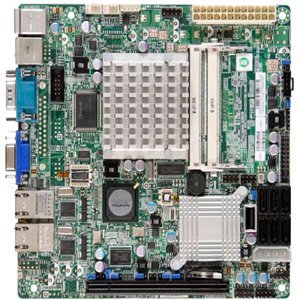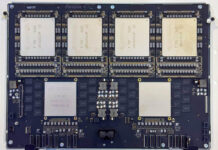Yesterday Intel announced the Atom D425 and D525 platforms targeted for small storage servers. Both chips are 1.8GHz parts with Hyper-Threading. The Atom D425 is a single core with 512KB of cache (10w TDP) and the Atom D525 (13w TDP) being the dual core chip with 1MB of L2 cache.
The chips support both the DDR2 like the Atom D410 and Atom D510 did, but also support DDR3 SODIMMs. Generally speaking, DDR3 SODIMMs use slightly less power than their DDR2 variants. The TDP of the new chips is identical to the older D410 and D510 chips rated at 1.66GHz.
In the news release, Intel touted the Atom D410 and D510’s penetration into low-end NAS products from partners such as Acer (for example the Acer Aspire easyStore AH342-U2T2H Home Server), Cisco, LaCie, LG Electronics, NETGEAR, QNAP, Super Micro, Synology and Thecus (ex. the Thecus N4200) and support for Windows Home Server and Linux NAS solutions.

Another key part of the announcement is the integration with the 82801 IR I/O Controller, which is basically Intel’s ICH9R. The Intel 82801 IR I/O Controller is a 4.3w TDP part that supports 12 USB ports, 6 SATA 3.0gbps channels, and a gigabit LAN connection. This is important because the standard integrated Atom chipset at this point supports only 2 SATA channels. As I have previously mentioned in my Atom D510 versus N330/ION Review and Comparison, two SATA ports is woefully inadequate for home servers. Supermicro’s X7SPA-HF is one example of the Intel 82801 IR I/O Controller’s integration with the D510 so hopefully we will see an update to that board with the D525.
The Servethehome.com View
Overall, the integration of the ICH9R and the Atom platform is essential for small storage servers. While the Pineview Atom platform does provide excellent idle and maximum power consumption, the Atom CPU is simply outmatched at times by the Windows Server 2008 R2 codebase that underlies Windows Server Vail and Aurora. That brings up an interesting dilemma for the new Atom platform as its launch is so close to both Vail and Aurora (my personal guess is by December 2010 we will see one or both launch) that it becomes questionable to purchase hardware that will be obsolete in three months. Another important note on the Pineview Atoms is the lack of Intel VT-x and VT-d virtualization extensions. With the proliferation of solid virtualization options these days and the low CPU requirements of basic NAS functions, it is another feature lacking from the Pineview platform that will lead to faster obsolescence.
On the other hand, upgrading from previous versions of Windows Home Server and other NAS platforms to either Vail and Aurora will require a user to re-format the data disks (due to the new drive extender). Practically, speaking, a lot of users will have requirements satisfied by the current WHS platform or a Linux/ FreeBSD OS. If this is the case, purchasing an Atom D525 system now makes a lot of sense.
The Atom D425 is something that frankly educated users should avoid. A 3w lower TDP (or 23% lower power consumption) for half of the computing power is a very hard to justify. This comes alongside a $20-25 difference in street price, which is negligible in a $1,000 server. Frankly, a single core Atom system, at this point, is rapidly approaching obsolescence. Windows Server Vail is a great example of an application where Atom chips are woefully underpowered, and the D425 will be even more so than the D510.




Another non-biased Intel “fanboy” viewpoint. Quite refreshing and great work.
Good point! I guess these are going to be ZFS only solutions. Thankyou Patrick
Interesting take on the subject and I agree fully with the lack of VT being a major issue, as the ability to run a virtual router/IP phone switch etc is very handy on a NAS. Still, Im suprised that youve found the performance of the Atom to be inadequate. Ill admit Ive never run WHS (thus making my comments invalid to 90% of your readers Im sure) but I found an atom 330 runs Windows Storage Server and Windows Server 2008R2 in the file serving role with ease. Even SIS passes werent too much of an issue and from a RAID 0 array it allows for 100MB/s transfers over the LAN.
It may be a crappy CPU but with the lack of any decent ARM alternative motherboards, I reckon its pretty much the best value file server chip on the market. Just dont ask it to do anything else…
It is not that you cannot do it, it is that you cannot do basic file serving plus a whole lot more. For example, Vail has video transcoding capabilities built in. The N330 and D510 are, in many cases, woefully inadequate to do this. Another issue is the 4GB of RAM limitation when moving to x64. My “standard” WHS installation uses up to 2.6GB when I am transferring big files to duplicated shares, have monitoring apps running and etc. Once you take into account the x64 memory overhead there is not a ton of room there.
For basic file serving, sure the D525 is fine. Once you start wanting to do things beyond that, it starts to be a bottle neck. This is especially true when one starts touching video transcoding which is a built-in Vail feature.
@Patrick. Fair enough, I guess this shows the short sightedness of Intels CPU/chipset strategy. Why wont they release low power desktop/consumer chips and chipsets? Im sure many people would pay a small premium for a “mobile” type cpu in a mATX board with 4 DIMM slots, just not the quadruple cost that vendors are currently charging.